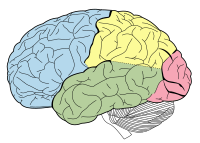
Photo from wikipedia
Flexible neural implants are extremely favored, as the most successful strategy to promote probe-tissue integration and avoid severe gliosis relies on reducing the mechanical mismatch between probe and brain tissue.… Click to show full abstract
Flexible neural implants are extremely favored, as the most successful strategy to promote probe-tissue integration and avoid severe gliosis relies on reducing the mechanical mismatch between probe and brain tissue. But what are the realistic requirements for achieving chronic recording stability? What are the critical dimensions and main factors determining glial scar-free device integration? To answer these questions, two types of hair-sized polyimide-based flexible intracortical (PIXI) arrays were fabricated, differing only in their cross-sectional area. Chronic tissue reaction to both types was evaluated in rats, and in different implantation setups. Interfacial stresses were found to play a critical role in long-term tissue integration. Still, all the devices provided high quality chronic recordings of single units and inflammatory gene expression was not significantly upregulated for larger devices. Our study points out that the most relevant factor in eliciting FBR is played by mechanical probe-tissue interactions, that polyimide is well tolerated by the tissue, and that a holistic design - considering material properties, geometrical dimensions and assembling techniques - is the key towards longevity and long-term performance of intracortical probes. The optimization of only one parameter did not yet lead to the successful translation of research accomplishments into chronic preclinical and clinical applications.
Journal Title: Biomaterials
Year Published: 2022
Link to full text (if available)
Share on Social Media: Sign Up to like & get
recommendations!